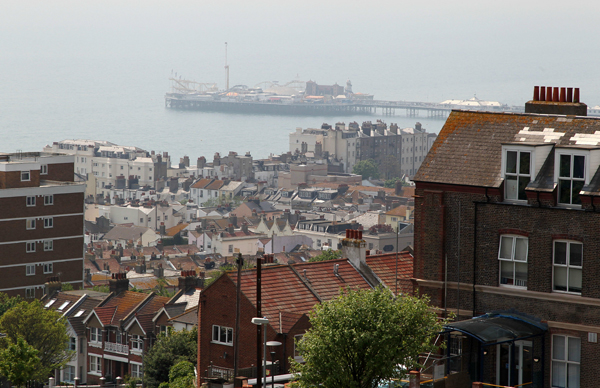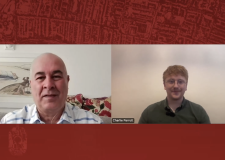Brighton & Hove – builders eye £100m prize
An ambitious four-year project to build thousands of homes is about to begin. Frank le Duc reports

The most recent census suggested that the population of Brighton and Hove had gone up by more than 10 per cent to 273,000 by last year. This was a bigger rise than expected. Over the next 20 years experts are predicting a need for between 16,000 and 19,000 extra homes to cater for our growing city. The need is made greater as we live in smaller households – more of us live by ourselves. Another factor is that some of the oldest housing is reaching the end of its natural life and will need to be replaced.
But if all those new homes were to be built, it would mean using just about every last bit of available land. And we would have to turn large numbers of offices, shops and warehouses into homes. Tony Mernagh, the executive director of Brighton and Hove Economic Partnership, said: “This would radically alter the nature of the city, effectively making it a dormitory town.”
Politicians from all parties locally seem to be settling on a figure of about 11,400 new homes as realistic and achievable. They also seem to be in agreement about the need to build 3,760 extra homes by 2030 for those with the greatest need. This would make a decent-sized dent in the number of people on the council housing waiting list which currently stands at more than 13,500. Of those, 1,380 were deemed to be in high need or very high need.
Even to achieve 11,400 new homes including 3,760 flats and houses for the poorest will prove to be a huge challenge. As part of its austerity package, the coalition government has scaled back spending on social housing – homes built by housing associations or council houses and flats. And it has tightened the overall spending of local authorities like Brighton and Hove City Council. This has restricted even further the room for manoeuvre.
A FRESH APPROACH
A few months ago, strategic director Geoff Raw told a housing summit at Hove Town Hall: “Current market conditions pose serious problems for delivery but they also present opportunities.” He said that the pressures included the demand for housing outstripping supply and the high cost of buying or renting a home even though wages locally are below average. He added that there was a shortage of land to build on and there were concerns about the viability of some developers.
Mr Raw also said that there were more households than homes and that this balance was set to worsen. The social rented sector was relatively small compared with the private sector and there was a “high need population with significant health inequalities and support needs”. The number of people presenting themselves as homeless had gone up, he said, from 754 in 2009-10 to 978 last year. Over the same period the number accepted as homeless went up from 368 to 496. And the number of new homes being built had tailed off markedly.
Quietly, though, officials have been working behind the scenes to come up with fresh ideas. In the past few weeks councillors have given their backing to a couple of these ideas. The first involves building homes on the sites of various garages. The locations have been picked. Officials are now about to choose a working partner to oversee the design and building of 29 homes at a cost of about £4.5 million at those sites in:
• Foredown Road, off Easthill Drive, Portslade
• Flint Close (south side), Portslade
• Mountfields off Hinton Close, Hollingdean
• Natal Road, off Lewes Road, Brighton
• Hardwick Road, off Harmsworth Crescent, Hangleton
• Rotherfield Crescent, Hollingbury
• Plumpton Road, Queen’s Park
• 4-7 Kensington Street and 15-20 Kensington Street land, Brighton
A GRAND PLAN
More significantly the council’s housing committee approved the spending of up to £1 million on consultants to draw up initial designs and consultations for a series of projects. This is the start of a £100 million four-year programme of building. If calculations by the housing charity Shelter are correct – that every £1 invested in housebuilding has a £3.51 multiplier effect – then the economy of Brighton and Hove will benefit from an injection of more than £350 million by 2017.
Despite the government’s austerity measures, it will be providing some of the money through its housing quango, the Homes and Communities Agency (HCA). The agency has even seconded a member of its team to work with the council on its plans. The track record under both the previous Conservative administration and the current Green leadership has helped. The council is building its first flats for years in Wellington Road, Brighton, and is working with housing associations such as Hyde and Southern on other projects.
As well as HCA funds, some of the £100 million will come from the council’s own coffers. And a significant sum will come from institutional investors. There is some satisfaction inside the council’s headquarters that a number of potential backers are lining up to do business. They see councils as a safe bet. After all, councils don’t tend to go bust. And while the welfare reforms may make life harder for those on benefits, for private investors, they make the safe and steady revenue stream from social housing seem more attractive.
Their revenue stream consists of the money raised from rents. This may well be used to repay the equivalent of a huge mortgage. No decisions have been taken on whether big private investors or housing associations will end up owning or managing the properties that they may help to fund. Or the exact level of involvement that they will have in the process. A proportion of the flats and houses will be bought by those who move in to them. The aim is for the people who currently live on the estates – and their councillors – to have their say before firm decisions are settled. Details will emerge scheme by scheme.
This won’t happen overnight. As Mr Raw said: “We’ve got to work up schemes. We’ve got to work up planning applications. And the investment model has to work.”
But the garage sites should be completed by the May 2015 elections if all goes well while the other sites are likely to take at least a year longer.
CARING SOLUTION
The spending programme has not been devised with just our future housing needs in mind. It takes into account our growing elderly population. And it addresses the sustainability agenda espoused by the Green Party. Replacing older buildings with more energy-efficient properties is one way of bringing down running costs. And as household gas and electricity bills have outpaced inflation, this has become more important. The elderly have faced tough choices about heating their homes. But every £1 saved on heating is available to spend locally.
At the housing summit, Denise D’Souza, the council’s director of adult social care, said that by 2030:
• An estimated 2,400 people aged 85+ will be living in Brighton and Hove – up 35 per cent
• Of those aged 85+ it is thought that up to 75 per cent will be experiencing a life-limiting illness which in turn is likely to affect the proportion of people able to maintain living in their own homes
• About 11,000 people will be aged 75+ years and living alone here
• More than half the older people in Brighton and Hove live in the 40 per cent most deprived areas for older people in England
She said: “In line with the roll out of more personalised support we continue to focus on people maintaining their independence for as long as possible and foster proportionate responses to people’s needs as they increase.” Traditional working patterns meant, she said, that there was still a significant dependence on two key care sectors – home care and residential or nursing homes. Both will remain important but the housing programme is intended to help address some social care issues too.
Newly built homes that are able to take wheelchairs, for example, can save the council a small fortune in fees paid to the providers of specialist accommodation. And it cuts out the need for expensive adaptations. Mrs D’Souza gave one illustration, saying that in August 2010 the cost of residential care in Brighton and Hove was between £325 and £438 a week. Few places were at the cheaper end of the scale. Keeping someone in their own home is much more cost-effective – and more often in line with what most people want.
The £100 million housing programme will not pay for itself overnight – or even over 10 or 15 years. But like a mortgage, the value is often felt over time. And when many councils are far more constrained when it comes to building flats and houses – or even encouraging others to do so – Mr Raw and his staff are able to be bold and have been given the political backing to make a difference.




















